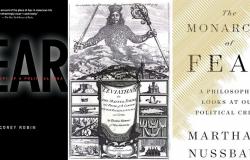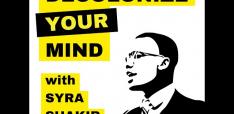How Fear and Anger Impact Democracy

In this Democracy Papers essay, George Marcus addresses the important role that emotions play in politics. In a timely contribution to essays on the Anxieties of Democracy, Marcus delves into what we might broadly call the anxieties of citizens, distinguishing between the political consequences of fear and anger. In order to effectively address negative emotions in democratic politics, politicians first need to understand their distinctive psychological origins and consequences.
Observing the rise of right-wing extremism across the world has led many to a familiar and long-established explanation: fear fosters support for far-right parties and politicians. This explanation continues a long tradition in political thought and commentary that attributes a foundational role to fear. In this essay, I will use new thinking about emotion that draws on recent scholarship in neuroscience and empirical research on the role of emotion in political reasoning to argue that scholars need to distinguish between fear and anger as distinct negative reactions, each with different political consequences. The popular focus on fear has obscured the role anger plays in pushing voters to extreme positions when facing political threats. In order to respond effectively to political threats, we need to understand the different emotions that threats elicit among citizens. Moreover, the political system needs to take into account that fear and anger each identify different features of threats, and each requires different political remedies. Responding as if all threats provoke fear and only fear will leave democracies vulnerable because of their inattention to anger.
What we have long believed
Even though anger is politically more potent than fear, it is the latter that has dominated political discourse and analysis; fear is the emotion that fascinates and frightens the human mind. For example, fear has long been claimed as a pillar of religious authority— that is used to secure submission to religious dictates as to faith and practice. The qualifier “god fearing,” commonly in use among Christians, illustrates this. Turning to a more secular and still political use of fear, Thomas Hobbes, in his magisterial Leviathan, sets aside religion: here, fear moves people to endorse the authority of the Leviathan. This old claim, that fear is a tool of political authority, remains widely influential. Today, fear continues to be the dominant theme in journalism, academia, and politics, and it is especially prominent in analyses of what happens when people are threatened (see figure 1).
Figure 1. Long-held views of the primacy and influence of fear on human affairs

In short, fear has long been cast as the principal means by which rulers and those seeking to rule try to maintain public order. Create fear and people will not challenge their ruler’s authority.
However, a key element of this interpretation is suspect: it ignores the independent role of anger. In fact, most of what has long been attributed to fear is actually a result of anger. Fear plays a very different and essential role than is commonly believed. In what follows, I advance the arguments that fear matters, but in a quite different manner than most understand; that anger matters especially in social movements; and that each is vital to a well-working democracy.
We have long sought to understand emotions, often casting them as hidden, mysterious, powerful, and generally negatively juxtaposed against reason. Before I explain why these understandings are wrong, I need to give some brief attention to the nature of conscious awareness and the functions of emotion.
What has long been hidden
Conscious awareness is normally experienced as holistic, offering instantaneous, vivid, and accurate access to the world before us. However, it is in actuality neither instantaneous nor particularly accurate in its representation.1 Our brains need time to generate the rich experience of consciousness; neuroscientists have measured that duration as 500 milliseconds.2 But the brain does not sit idle as this half second goes by. Because conscious awareness is both slow and imprecise, the brain additionally relies on many preconscious appraisals to inform and guide our conscious interpretation of the world. These preconscious processes of interpretation occur every time we consciously undertake a dedicated task.3 Emotions are a key part of all preconscious activity, and this means that what fear and anger actually do is largely hidden from us.
In the preconscious realm we are experiencing not one emotion (the conventional expectation given what transpires in the conscious realm), but three different emotions. The processes that produce these emotions are known as the three modulating affective appraisals in the scientific literature. The three appraisals each assess a distinct feature of the world and each produce a distinct emotion: fear, anger, and enthusiasm.
The swift modulation that occurs on a range running from depressed to elated—producing the emotion which we label enthusiasm—gives the closest to real-time appraisal of how well our habits and energy resources are performing as the brain seeks to execute reward-seeking actions. Sitting before a keyboard, facing an imminent deadline, after a too-late night of binging, might find us fumbling and feeling disappointed. A thudding backhand tennis shot that wins a set will likely find us elated, and engender confidence as our play continues.4
But we live in a world that is too often neither familiar nor safe. Happily, we have other appraisals that investigate threat, one of which tells us whether our environments are familiar or not, and which produces the feeling of fear when it detects a departure from the usual. For if our environment is familiar, our proven habits of thought and action predict successful performance. If our environment is not familiar, then relying on past practices would seem to be ill-advised—in these situations, the feeling of fear serves us by breaking our reliance on habit and making us consider alternative courses of action.
Yet another swift preconscious appraisal is dedicated to assessing whether we face a noxious threat; this appraisal produces its answer by modulating levels of anger.
This focus on three emotions and their preconscious roles is a major revision to how we think perception works, especially how we respond to threats. Threats are not dealt with as holistic events. Rather, our brains begin by identifying two facets, different in their foci and different in their consequences for effective response. I will discuss these two facets in more detail below.
What fear and anger do
Though fear and anger are often treated as parallel negative emotions, they are actually very different in both their genesis and their role in how we think and act. Each appraisal is focused and neither is holistic. Each originates in a continuous and preconscious process of appraising our environment, no matter whether we are facing a threat or not. Hence, the search for unfamiliarity, which triggers fear, is continuous, as is the search for toxicity, which triggers anger.
What do these two appraisals tell us to expect as threats intrude into our lives? In brief, the theory of affective intelligence, on which this essay is based, presents four hypotheses: Two hypotheses predict how fear and anger directly generate a response to threat. The other two present the indirect effect of fear and anger, as each appraisal has consequences on how we rely on habituated dispositions. These four hypotheses are presented in table 1 below.
Table 1. The contrary influences of fear and anger

The first hypothesis is that increasing fear identifies departures from the expected. Heightened fear prompts an open search for information, in order to better identify this departure’s specific features, the possible options for action, and the possibility of new coalitions; all of this is designed to minimize risk. Hence, directly, increasingfearfulness lessens the desire for aggressive, risk-taking ventures.
The second hypothesis is that increasing anger identifies that we are facing a noxious threat on core values and practices. Anger builds up resistance to contrary information. Increasing anger thus increases support for leaders and parties that present strength and policies proclaimed to defend the community, region, or nation.
The third and fourth hypotheses postulate indirect effects of emotion. Hypothesis three proposes that increasing fear reduces the influence of otherwise salient political dispositions, and that fearful citizens will be less influenced by their partisan attachments or their ideological convictions. Hypothesis four proposes that increasing anger strengthens the influence of salient political dispositions.
These four hypotheses directly challenge prevailing presumptions that fear is the primary singular route by which threats influence us. There is a rich empirical literature that seems to confirm the conventional account that fear causes people to seek strong conservative leaders and to endorse authoritarian policies and parties.5 Yet, many of these studies accept the dominance and preponderance of fear as the principal response to threat; they do not identify or empirically test for the role of anger (and many of them do not even measure fear). Putting the theorizing aside, I will now turn to empirical evidence and ask how well this alternative account works when we measure people’s anger and fear.
Some evidence on what fear and anger actually do
Fear serves one purpose and anger serves a quite different one. To fully grasp what each emotion does, we need to measure each in a manner that yields reliable and valid measures. In a recent study, my colleagues and I measured the effects of each emotion and found considerable evidence, all which yielded nearly identical results, whether collected in the United States, Germany, Norway, the Netherlands, Austria, or France.6 We first developed methods that ask people to rate how they feel about a political leader, candidate or group, or event (e.g., the 2015 Paris terrorist attack). To gauge respondents’ anger and fear, we asked them to rate their emotions using emotion words such as how bitter and how much hatred they felt, or how worriedand scared they were.
I will present two representative studies that reveal how fear and anger each influenced voting for the Front national (now called Rassemblement national) in two recent elections. Figure 2 shows the direct relationships between fear and anger on the one hand, and voting for the Front national in 2015 on the other hand. Figure 3 shows the indirect effects of fear and anger on the vote for Marine Le Pen in the first round of the 2017 presidential election.
Conventional wisdom holds that the more fearful should be attracted to the appeal of this party, which has long presented itself as nationalist, a defender of traditional values, and anti-immigrant. Far-right parties in other countries have seemingly gained support making similar appeals. Our account makes two quite different predictions: the more fearful will be less likely and the more angry more likely to support the Front national.
The first study examined the role of emotion in shaping how the French voted in the 2015 national elections. These elections were held just weeks after the horrific Paris terror attacks of November 13 of that year. Though not shown here, when we assess the direct relationship between fear and voting for the Front National, while not controlling for the independent impact of anger, fear is indeed related to voting for this far-right party.7 However, as shown in figure 2, when we account for both emotions, then greater fear led to less support and greater anger led to greater support for Front national candidates.
Figure 2. The direct effects of fear and anger in appraising the 2015 Paris terror attacks on voting for Front national candidates in the 2015 national elections

The same pattern of results shown in figure 2 was found when examining the 2017 French presidential elections.9 For this study, we asked French people how they felt about “France today.” Did fear work to Le Pen’s advantage as conventional wisdom holds, or, as the theory of affective intelligence holds, against? And, what role did anger play? The results of increased fear and increased anger in 2017 were near duplicates of those shown for 2015.
Let’s turn to the influence of these two emotions on the most influential of political dispositions, political ideology. In the French national election survey participants were asked to identify their ideological predilections using a 10-point scale. Their choices ranged from farthest left (1) to farthest right (10). Le Pen and her party have long drawn their support, as most parties and leaders do, from their ideological base. Hence, those identifying as right, or far right, are expected in the “normal vote” view to show robust continuity by relying on their predilections, much as liberals and conservatives do in the United States.10 Affective intelligence theory predicts that fearful right ideological identifiers will become less loyal, while angry right ideological identifiers will show greater loyalty.
Figure 3. The modulating effects of fear and of anger about France today in voting for Le Pen in the 2017 presidential election, first round

The top line of figure 3 shows the key results from this study. For far right voters, as fear increases, they become less inclined to vote for Le Pen (the line slopes down as fear goes from minimal to maximal). On the other hand, as anger increases, far-right voters, more so than any other group, become far more likely to support Le Pen. Increased anger mobilized base voters in this election, as in elections elsewhere, but increased fear did not. Another important point—across many studies, the incremental impact of greater anger has proved to be more robust than the incremental impact of greater fear. Ignoring threat-induced anger leaves us all in a state of ignorance when we try to deal with the many threats before us.
The different ramifications of fear and of anger
Politicians, journalists, scholars, and pundits seek to understand threat and then voice what they believe will be an effective response. But effective responses to any given threat need to be properly explained to the public if they are to work. Proposals and rhetoric meant to quiet anxiety will not assuage those who are angry. Similarly, those who are fearful are looking for new and persuasive accounts that help them make sense of the novel threats they face, preferably accompanied by a credible promise of addressing the threat effectively. In heterogeneous societies, some will be more angry than fearful, and others the reverse. Notwithstanding which is the greater and among which subpopulations, all citizens have their political understandings shaped by both fear and anger. Good governance, good journalism, good scholarship, and good citizenship depend on knowing the valuable, even essential roles, that anger—by identifying noxious threats—and fear—by identifying when we are in unfamiliar waters—play. Ignoring anger and misunderstanding fear will leave us blind and helpless.
George E. Marcus is emeritus professor of political science at Williams College. He does research in political psychology, political methodology, and elections, public opinion and voting behavior. His most central current project is “The Upcoming Elections in Europe.” His focus has been on political tolerance, the role of emotions in politics, and reimagining democratic theory in light of the insights into the ancient but now archaic opposition of reason and passion provided by neuroscience. He has written a number of books, among them: Political Tolerance and American Democracy (with John L. Sullivan and James E. Piereson; The University of Chicago Press, 1982, 1989, 1993); With Malice toward Some: How People Make Civil Liberties Judgments (with John L. Sullivan, Elizabeth Theiss-Morse, and Sandra L. Wood; Cambridge University Press, 1995); Affective Intelligence and Political Judgment (with W. Russell Neuman and Michael MacKuen; The University of Chicago Press, 2000); and The Sentimental Citizen (Penn State University Press, 2002; French language edition, Les Presses de Sciences Po, 2009). He also coauthored, with Stanley Feldman and Leonie Huddy, Going to War in Iraq: When Citizens and the Press Matter (The University of Chicago Press, 2015). His research can be found on ResearchGate.
This first appeared on the Social Science Research Council's items blog.


